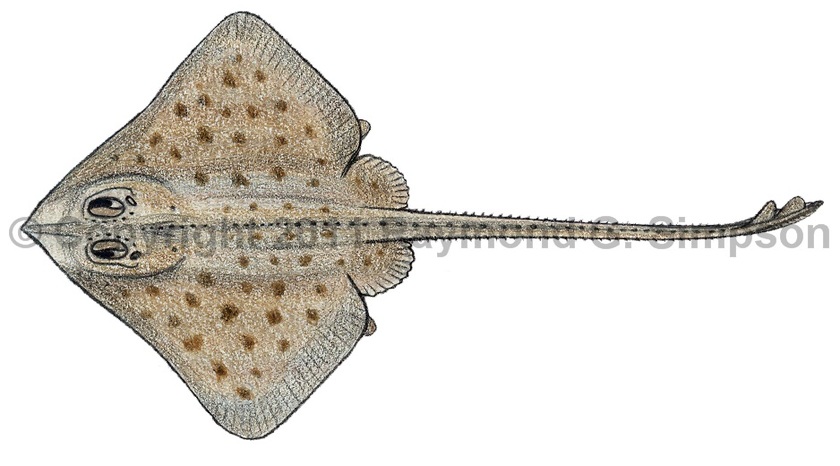
Common Name
Broadfoot Legskate
Year Described
Bigelow & Schroeder, 1962
Identification
Disk rhomboidal with a slightly concave anterior margin of snout and pectoral fin. Snout moderately long (~14% TL) with stiff rostral cartilage. Pectoral fins with rounded tips. Anterior pelvic fin lobe separated from posterior lobe and greatly elongated; about as long as the squared-off posterior lobe. Tail is long and thin. Posterior part of tail with skin folds that broaden toward tip. There are two dorsal fins placed far back on tail with distance between them half the width of the first dorsal fin. Caudal fin is barely evident and tapers to a round tip. Eyes and mouth large. Jaws with 40-46 tooth rows. Male claspers thin and long.
Body is densely covered with dermal denticles dorsally. The rostrum has around 10 thorns. There are around 11 orbital thorns, and 5 nuchal thorns on the head. Two paired scapular thorns. Posterior abdomen with 27-30 thorns (small gap on anterior abdomen). Tail with a double median row of 32-35 thorns. A few parallel rows of lateral thorns. There are no thorns present between the dorsal fins. Ventral surface without dermal denticles except for under tail.
Color
Dorsum uniformly light to medium brown with faint spots that are orbit-sized or smaller. Fins and tail unmarked pale brown. Ventrum pale with grayish edges and white tail.
Size
Maximum size to 38cm TL.
Habitat
A deepwater skate taken on continental slopes and outer shelves from 455-900m.
Range
Known from off Florida and Puerto Rico.
References
Last, P.R., White, W.T., Carvalho, M.R. de, Séret, B., Stehmann, M.F.W & Naylor, G.J.P (Eds.). 2016. Rays of the World. CSIRO Publishing, Melbourne.
Other Notes
Easily differentiated from the rough skinned Cruriraja rugosa by the presence of scapular thorns and more median thorns in total.